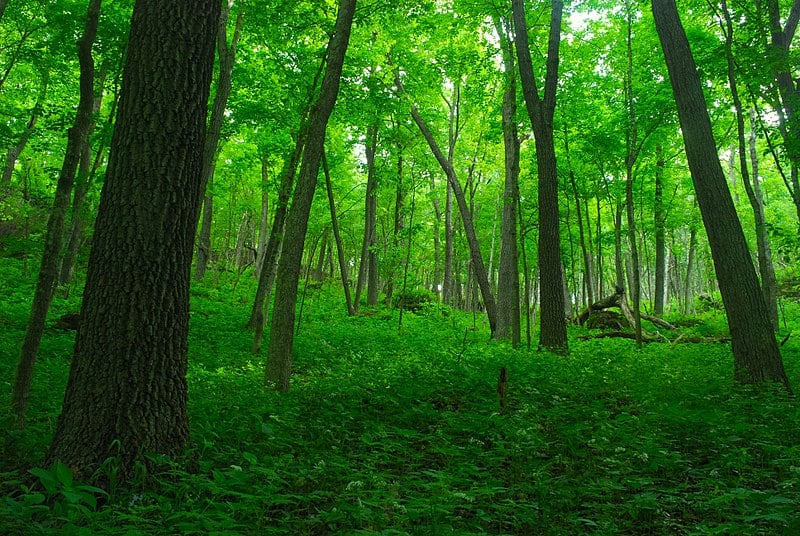Sustainability in Ecosystems & Agriculture (DP IB Biology): Revision Note
Assessing Sustainability of Resource Harvesting
Human activities rely on the harvesting of resources, such as food and timber, for which we rely on the natural environment
A sustainably harvested resource is one which is replaced as rapidly as it is harvested, meaning that it does not run out
In order for a resource to be sustainable, its use needs to be carefully regulated and monitored to ensure that it is not over-harvested
Terrestrial plant: black cherry
Black cherry is a species of hardwood tree, found in North America, that is popular for furniture production
Hardwood tree species grow slowly, so it is especially important that sustainable harvesting methods are used; methods such as clear felling will leave no timber for many years to come
Sustainable harvesting of black cherry timber involves
Selective felling; choosing specific individual trees to harvest, leaving gaps in the forest canopy that will encourage growth of more plants on the forest floor
Leaving enough individuals behind in the forest to flower and produce seeds, ensuring that new black cherry saplings will germinate
Regular monitoring to ensure that new growth is keeping up with logging

CC BY-SA 2.0, via Wikimedia Commons (opens in a new tab)
Hardwood forests contain trees that grow slowly, so harvesting must be carefully managed
Marine fish: Alaska pollock
Pollock are a species of fish found across the North Pacific
The Alaska pollock fishery is the largest sustainably certified fishery in the world
This certification is awarded by the Marine Stewardship Council (MSC)
The fishery is considered to be sustainable because
Pollock are a fast-growing species which can reproduce from the age of 3-4 years
Nets have minimal contact with the sea bed, so do not damage this habitat
The proportion of the fish caught that are not pollock, known as bycatch, is very low; less than 1 %
According to regulation, any bycatch that is caught cannot be sold commercially, so it is in the interest of fishermen to avoid catching it
Close monitoring is carried out by science research vessels and by trained individuals on board commercial fishing vessels
Any areas where a higher than normal number of salmon bycatch occurs are closed off to fishing vessels

CC BY-SA 4.0, via Wikimedia Commons (opens in a new tab)
Wild Alaska pollock caught in the US is a sustainably harvested resource
Factors Affecting Sustainability of Agriculture
Agriculture is essential in ensuring that there are enough food and materials to supply the needs of humans around the world
Sustainability in agriculture is a complex challenge influenced by many factors
Soil erosion
In order to grow crops or keep large numbers of grazing animals, land needs to be cleared to make space for crops or grass
The removal of larger trees and shrubs means that the roots that hold the soil together are lost, resulting in less stable soil that can easily be washed or blown away
This is a particular risk for the nutrient-rich upper soil layer, known as topsoil
This leads to soil erosion, and a reduction in the availability of soil needed for crop/grass growth
While crops and grass themselves can aid soil stability, they may only provide partial cover, or they may be removed after harvest, or due to overgrazing/poor weather
Farmers sometimes plant 'cover crops' to hold the topsoil together in between growing seasons
Leaching and nutrient run-off
The use of synthetic fertilisers in agriculture can lead to nutrient runoff due to leaching
This occurs when rainfall washes fertilisers out of the soil and into nearby bodies of water
The minerals in synthetic fertilisers are highly soluble so dissolve in rainwater before being washed away
The problem of leaching can be reduced by applying fertilisers in small volumes, at times when rain is not forecast, and by using organic rather than synthetic fertilisers
Fertiliser supply
Chemical fertilisers are important for many farmers, but they are not always easy to supply
They are expensive
They are used by many farmers, so supply may not meet the large demand
The process of fertiliser production is very energy intensive, so the cost of fertilisers is affected by the global energy prices
Switching to organic fertilisers can help to reduce some of the difficulties associated with chemical fertiliser use
Pollution
Some types of farming rely on the use of chemicals, known as agrochemicals
The impact of chemical fertiliser use has been described above
Additional examples of agrochemicals include
Pesticides
Herbicides
Fungicides
These chemicals are used to improve yield, which might otherwise be damaged by insect pests, competition from weeds, or by fungal disease
These chemicals can enter the natural environment and cause problems, e.g. by killing non-target species
Biological pest control can reduce pesticide use
This involves the release of a pest's natural predators, e.g. ladybirds that prey on aphids
Scientists hope that genetic modification may allow the introduction of crop varieties that are resistant to pests and disease
Carbon footprint
The reliance on fossil fuels for transportation, machinery, and the production of synthetic fertilisers has significant implications for the sustainability of food production
The combustion of fossil fuels releases carbon dioxide into the atmosphere, increasing the carbon footprint of agriculture and contributing to climate change
Transitioning to renewable energy sources and promoting energy-efficient practices can help reduce the carbon footprint of food production

Many are concerned about sustainability problems in intensive agriculture

Unlock more, it's free!
Did this page help you?